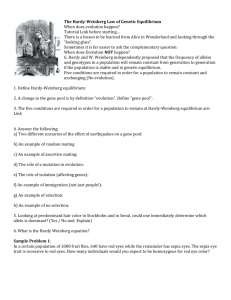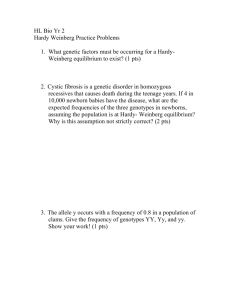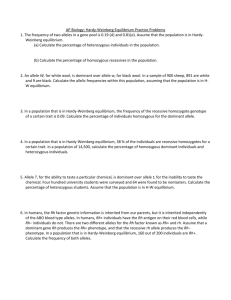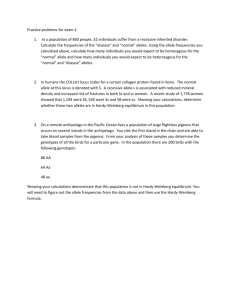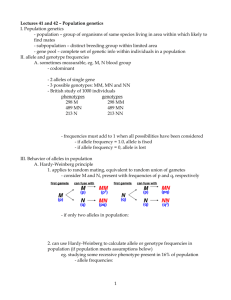Answers
advertisement
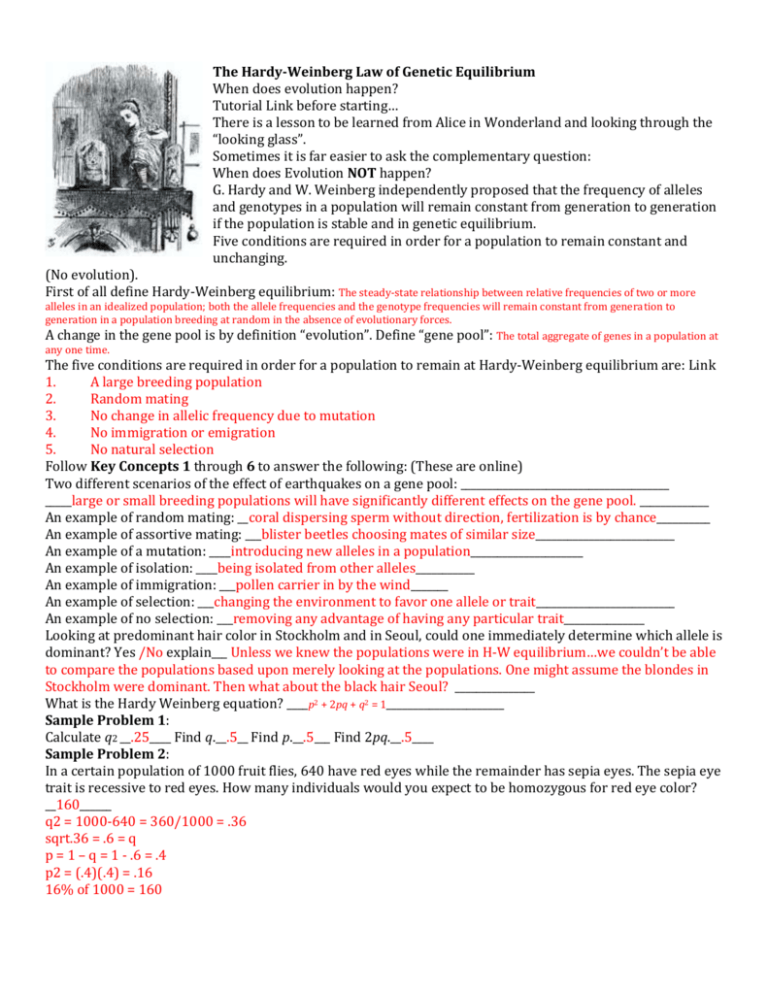
The Hardy-Weinberg Law of Genetic Equilibrium When does evolution happen? Tutorial Link before starting… There is a lesson to be learned from Alice in Wonderland and looking through the “looking glass”. Sometimes it is far easier to ask the complementary question: When does Evolution NOT happen? G. Hardy and W. Weinberg independently proposed that the frequency of alleles and genotypes in a population will remain constant from generation to generation if the population is stable and in genetic equilibrium. Five conditions are required in order for a population to remain constant and unchanging. (No evolution). First of all define Hardy-Weinberg equilibrium: The steady-state relationship between relative frequencies of two or more alleles in an idealized population; both the allele frequencies and the genotype frequencies will remain constant from generation to generation in a population breeding at random in the absence of evolutionary forces. A change in the gene pool is by definition “evolution”. Define “gene pool”: The total aggregate of genes in a population at any one time. The five conditions are required in order for a population to remain at Hardy-Weinberg equilibrium are: Link 1. A large breeding population 2. Random mating 3. No change in allelic frequency due to mutation 4. No immigration or emigration 5. No natural selection Follow Key Concepts 1 through 6 to answer the following: (These are online) Two different scenarios of the effect of earthquakes on a gene pool: _______________________________________ _____large or small breeding populations will have significantly different effects on the gene pool. _____________ An example of random mating: __coral dispersing sperm without direction, fertilization is by chance__________ An example of assortive mating: ___blister beetles choosing mates of similar size__________________________ An example of a mutation: ____introducing new alleles in a population_____________________ An example of isolation: ____being isolated from other alleles___________ An example of immigration: ___pollen carrier in by the wind_______ An example of selection: ___changing the environment to favor one allele or trait__________________________ An example of no selection: ___removing any advantage of having any particular trait_______________ Looking at predominant hair color in Stockholm and in Seoul, could one immediately determine which allele is dominant? Yes /No explain___ Unless we knew the populations were in H-W equilibrium…we couldn’t be able to compare the populations based upon merely looking at the populations. One might assume the blondes in Stockholm were dominant. Then what about the black hair Seoul? _______________ What is the Hardy Weinberg equation? ____p2 + 2pq + q2 = 1______________________ Sample Problem 1: Calculate q2 __.25____ Find q.__.5__ Find p.__.5___ Find 2pq.__.5____ Sample Problem 2: In a certain population of 1000 fruit flies, 640 have red eyes while the remainder has sepia eyes. The sepia eye trait is recessive to red eyes. How many individuals would you expect to be homozygous for red eye color? __160______ q2 = 1000-640 = 360/1000 = .36 sqrt.36 = .6 = q p = 1 – q = 1 - .6 = .4 p2 = (.4)(.4) = .16 16% of 1000 = 160 Sample Problem 3: Phenylketonuria (PKU) is a human metabolic disorder that results in mental retardation if it is untreated in infancy. In the United States, one out of approximately 10,000 babies is born with the disorder. Approximately what percent of the population are heterozygous carriers of the recessive PKU allele? __________ q2= 1/10,000 = 0.0001 q= = 0.01 p = 1 - q = 1 - 0.01 = 0.99 The carriers are heterozygous. Therefore, 2pq = 2 (0.99) (0.01) = 0.0198= 1.98% Time out!!! Whoa Nelly! This can be confusing! Homozygous individuals stricken with PKU never have children. Go back to page 1 and list any HardyWeinberg Equilibrium condition(s) not being met with the PKU example cited above. ____Natural selection would be the biggest problem here. There would also be the condition of random mating… there is no mating. There is, of course, random mutations occurring all the time. ____________________________ Time out – continued. Let’s compare two Mugwump populations which inherit coat colour accordingly: BB is bronze, Bb is speckled (excellent camouflage against lichen) and bb is white. An isolated population has 10 000 individuals: 3600 Bronze - 4800 Speckled - 1600 White ; for a total of 10 000 in the population A different isolated population also has 10 000 individuals 3000 Bronze – 6000 Speckled – 1000 White ; again for a total of 10 000 individuals. First Population: p = _____.6_________ & q = ______.4______ Second Population: p = ___.68___ & q = ___.32___ One population is in HW equilibrium, while the other population is decidedly NOT in Hardy-Weinberg Equilibrium. Identify which is which. The first / second population is in Hardy Weinberg Equilibrium (circle one) The first / second population is NOT in Hardy Weinberg Equilibrium (circle one) Provide a possible explanation why one population is not in Hardy Weinberg Equilibrium. ____There could have been random mutation but most likely there was some sort of genetic drift___________ Homozygous recessive sickle cell anaemia is lethal and stricken individuals rarely have children. Yet in some regions of the world, the frequency of the sickle cell allele (q) is increasing over time. Why would that be? Explain. ______Selection in some areas favors the heterozygous form. These individuals keep the allele in the population and possibly increase its frequency. _____________________________ In other regions of the world, the frequency of the sickle cell allele (q) is remaining constant over time. Does unchanging p & q constancy indicate Hardy Weinberg Equilibrium has been achieved? Explain. Yes / No ___ Unchanging allele frequencies indicate that H-W equilibrium has been achieved. _________ What about Sickle Cell Anemia North America? Is p & q for Sickle Cell Anemia changing in North America? Explain. _________One would have to assume that p & q are changing in North America due to immigration, mutations, and non-random mating. ______ Elusive Mugwumps can be very shy. Here is a very rare photo of a bronze Mugwump. Allelic Frequency vs. Genotypic Frequency: If you are told that the frequency of a recessive allele in a population is 10%, what is q for this population? ______.1_____________ If you observe a population and find that 16% show the recessive trait, you know the frequency of the aa genotype. This means you know q2. What is q for this population? __.4___ A class of 12 AP biology students gathered the following data: Initial class frequencies: AA 3 Aa 6 aa 3 Final class frequencies: AA 2 Aa 5 aa 5 1. What are the initial p and q? .5/.5 2. What are the final p and q? .65/.35 3. Is the population in Hardy-Weinberg equilibrium? Explain your response. ____No. The allele frequencies change. There must be some sort of genetic drift._________ Here is a virtual experiment that demonstrates evolution over 200 years during the Industrial Revolution in England: Link What underlying law of nature has produces this change in numbers? ___Natural Selection_______ 500 light colored moths and 500 dark colored moths are released into a polluted forest. After 2 days the moths were recaptured, make a prediction about the number of each type of moth that would be captured. ________400 dark, 100 light… just an example. ___________________ Another Tutorial Link before continuing: Four evolutionary pressures that cause populations to change: ________genetic drift, gene flow, non-random mating, natural selection ________________________________________________________________________ ________________________________________________________________________________ ________________________________________________________________________________ ________________________________________________________________________________ Two causes of “Genetic Drift” would be: the ______Bottleneck_______ Effect & the___Founder_______ Effect Natural selection changes allele frequency, and therefore the accumulation of favorable traits, in three ways: Stabilizing, directional, or disruptive (diversifying) selection Identify the three kinds of graphs: A ______Stabilizing ____ selection B ______Directional _____ selection C _______Disruptive _____ selection Explain what could have caused two separate populations in graph 3. ___________having the intermediate form is not beneficial, such as in the case for beak thickness in finches_______ ABC Witness yourself how a new species can evolve: Link Five extraordinary examples of adaptive radiation sharing a common ancestor (click on gallery) ____________________________ __________________________ _______________________ ____________________________ __________________________ Quiz: Tom Mueller RHS

